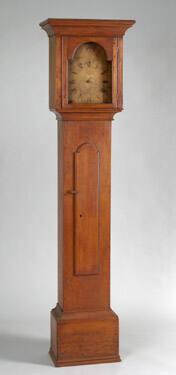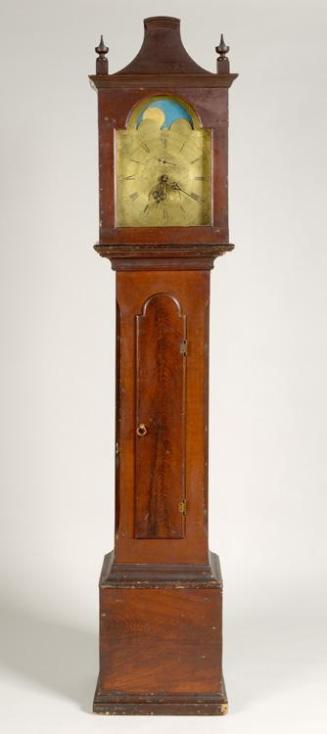Tall Case Clock
ClockmakerClock works made by
Gideon Roberts
(American, 1749 - 1813)
Furniture MakerCase made by
Unknown
Date1805-1815
MediumCase: Pine primary wood.
Dial: Printed laid paper, wood.
Clock Works: Wood.
DimensionsPrimary Dimensions (overall height x width x depth): 81 x 20 3/4 x 11 3/4in. (205.7 x 52.7 x 29.8cm)
ClassificationsClocks
Credit LineBequest of George Dudley Seymour
Object number1945.1.1169
DescriptionTall case in the Federal, or neoclassical, style, with a pine case, a flat-top hood, a wooden clock movement, and a paper dial printed "G. Roberts/ BRISTOL/ No" with the number "511" hand-written in black ink underneath. The tall case clock consists of three major components: the removable hood, the removable dial and clock works, and the clock case. The dial and works sit on a horizontal board at the top of the clock case; the pendulum and weights (now missing) that drive the works would be suspended in the trunk, or narrow body, of the case. The hood slides over the works and sits at the top of the case.
The top of the flat hood has projecting cove, or recessed quarter-circle, molding at the front and sides. The front of the hood has a glass window that is arched and recessed (the glass is missing). The trunk of the clock case has deep cove molding at the top and bottom, and a tall rectangular door on the front. The door has an arched top and ovolo, or thumbnail, molding on each side. A small wooden latch holds the door closed at the left side; below this is a keyhole. Base molding circles the lower front and sides of the base. The case has an overall red stain.
Construction Details: A single, vertically-oriented backboard with square top corners extends the full height of the hood and case. The hood does not have a back; it slides over the clock works to rest on the cove molding at the top of the trunk. The hood is constructed of a three-part frame, with a flat top and two sides that are dovetailed at the top corners. The cove molding is nailed to the front and sides of the hood. A vertical rail is nailed to the front edge of each side of the hood. The door of the hood is constructed of a four-sided frame that is joined with tenons at each corner. The outside and inside edge of each side of the door frame has ovolo, or thumbnail, molding. The door pivots on a pair of brass hinges at the top right and bottom right corner.
The backboard is nailed into a rabbet on each back corner of the sides of the trunk; the nails are inserted through the sides of the trunk. The boards that form the front and sides of the trunk extend several inches above the bottom of the hood. The clock works rest on a seat board, or horizontal board immediately behind the dial. The seat board sits at the top edge of each side of the trunk. The cove molding is nailed to the front and sides of the top and bottom of the trunk. The front of the trunk is constructed of a single board, with an opening for the door, that is nailed to the front edges of the sides of the trunk. The door is joined to the trunk with a pair of hinges at the right side. The front and sides of the trunk extend down to the floor, as does the backboard. The base is constructed of a front and two side boards that are joined to each other at the front corners with a nailed butt joint. The base molding is nailed to the bottom edges of the front and sides of the base. There is no bottom board on the base.
Dial: The dial is square with an arched top, and consists of a paper dial printed with black ink, applied to a wooden backing (the paper dial is uniformly discolored). The paper dial was printed using an engraved metal plate; portions of the printed dial are painted brown (the paint is faded). The top of the dial arch is outlined with swags, over a bird inside a floral, oval wreath. The center of the square dial plate has a chapter ring, consisting of a ring of Roman numerals, inside a ring of minute graduations, inside a ring of Arabic numbers from one to sixty in increments of five. In the center of the chapter ring is an arbor, or axle, around which the hour and minute hands pivot (the hour and minute hands are missing). Above this is an applied, round paper medallion printed "G. Roberts/ BRISTOL/ No", with the number "511" hand-written in black ink underneath. Each corner of the dial plate has floral designs inside a triangular border.
Clock Works
Movement: weight driven
Duration: thirty hour
Materials: wood; oak plates, cherry gears
Strike: count wheel
Escapement: recoil
There are more than three inches between the plates. The bell is probably replaced.
Condition: The glass in the door of the hood is missing. The locking mechanism on the door of the trunk is missing. The case is refinished. The printed paper is badly stained and discolored as a result of being in contact with the wooden dial. The hour and minute hands are missing. The works have been cleaned. The bell is probably replaced. A pin is missing from the dial. The pendulum, pendulum bob, and weights are missing.
The top of the flat hood has projecting cove, or recessed quarter-circle, molding at the front and sides. The front of the hood has a glass window that is arched and recessed (the glass is missing). The trunk of the clock case has deep cove molding at the top and bottom, and a tall rectangular door on the front. The door has an arched top and ovolo, or thumbnail, molding on each side. A small wooden latch holds the door closed at the left side; below this is a keyhole. Base molding circles the lower front and sides of the base. The case has an overall red stain.
Construction Details: A single, vertically-oriented backboard with square top corners extends the full height of the hood and case. The hood does not have a back; it slides over the clock works to rest on the cove molding at the top of the trunk. The hood is constructed of a three-part frame, with a flat top and two sides that are dovetailed at the top corners. The cove molding is nailed to the front and sides of the hood. A vertical rail is nailed to the front edge of each side of the hood. The door of the hood is constructed of a four-sided frame that is joined with tenons at each corner. The outside and inside edge of each side of the door frame has ovolo, or thumbnail, molding. The door pivots on a pair of brass hinges at the top right and bottom right corner.
The backboard is nailed into a rabbet on each back corner of the sides of the trunk; the nails are inserted through the sides of the trunk. The boards that form the front and sides of the trunk extend several inches above the bottom of the hood. The clock works rest on a seat board, or horizontal board immediately behind the dial. The seat board sits at the top edge of each side of the trunk. The cove molding is nailed to the front and sides of the top and bottom of the trunk. The front of the trunk is constructed of a single board, with an opening for the door, that is nailed to the front edges of the sides of the trunk. The door is joined to the trunk with a pair of hinges at the right side. The front and sides of the trunk extend down to the floor, as does the backboard. The base is constructed of a front and two side boards that are joined to each other at the front corners with a nailed butt joint. The base molding is nailed to the bottom edges of the front and sides of the base. There is no bottom board on the base.
Dial: The dial is square with an arched top, and consists of a paper dial printed with black ink, applied to a wooden backing (the paper dial is uniformly discolored). The paper dial was printed using an engraved metal plate; portions of the printed dial are painted brown (the paint is faded). The top of the dial arch is outlined with swags, over a bird inside a floral, oval wreath. The center of the square dial plate has a chapter ring, consisting of a ring of Roman numerals, inside a ring of minute graduations, inside a ring of Arabic numbers from one to sixty in increments of five. In the center of the chapter ring is an arbor, or axle, around which the hour and minute hands pivot (the hour and minute hands are missing). Above this is an applied, round paper medallion printed "G. Roberts/ BRISTOL/ No", with the number "511" hand-written in black ink underneath. Each corner of the dial plate has floral designs inside a triangular border.
Clock Works
Movement: weight driven
Duration: thirty hour
Materials: wood; oak plates, cherry gears
Strike: count wheel
Escapement: recoil
There are more than three inches between the plates. The bell is probably replaced.
Condition: The glass in the door of the hood is missing. The locking mechanism on the door of the trunk is missing. The case is refinished. The printed paper is badly stained and discolored as a result of being in contact with the wooden dial. The hour and minute hands are missing. The works have been cleaned. The bell is probably replaced. A pin is missing from the dial. The pendulum, pendulum bob, and weights are missing.
Status
Not on view








